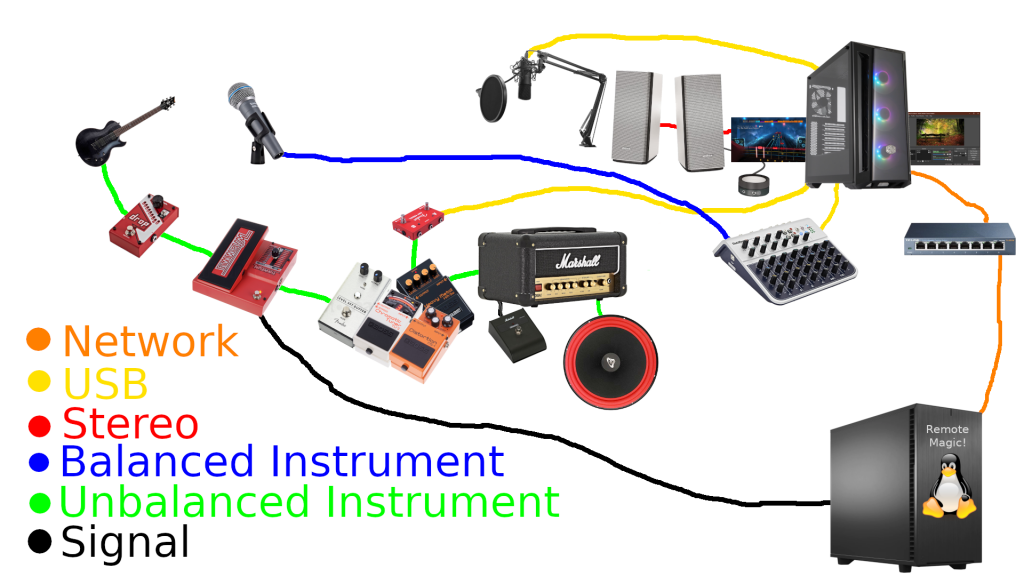Streaming Setup as of February 2023
Every Twitch Streamer‘s setup is something that evolves over time. Mine is no exception. Before I start describing my setup, a service announcement. My setup is by no means an example of how to make your own. I do several things unnecessary complicated, because I can, not because it is best practice. Problems I encounter should serve as a proof of not doing it my way.
When I started streaming I started out more or less as most others. A computer, a webcam, a cheap headset with mic. Also just as most streamers, you discover that this isn’t adequate by a mile, and start altering stuff.
Since I was mainly streaming Rocksmith, the headset was the first ting that had to go. The cabled headset had too short cable, and the wireless headset compressed audio too much. The solution was to get output on speakers. This combined with a mic via a SubZero interface, and everything worked fine. Or did it? Apparently I was using the mic wrong AND the sound of the speakers was picked up by the mic, creating a garbled noise, that made things even worse on the next change.
Again, mainly streaming Rocksmith, and since I now was on speakers, why not replace the crappy clean tones in Rocksmith 2014 with a real amp? I invested in a Marshall DSL1H top, and pluged in a Cervin Vega AT15 cab. Not the ideal cab for the amp, but it gave me a lot of sound, so much in fact, that the mic is now totally useless while playing songs.
There are lots of nifty addons to get to Rocksmith 2014, that enhances a streaming experience with it. Most streamers uses RSPlaylist for viewers to request songs, so do I. Lots of streamers uses RSMods to alter the behaviour of Rocksmith 2014, so do I, such as removing background, muting “Rocksmith Dad”, etc. Most streamers use Rocksniffer to have an overlay with current played song, so do I. Many streamers use Rocksmith-Scene-Switcher to change between a menu scene and an in-song scene, so do I.
But since Rocksniffer can expose its data remotely, and Rocksmith-Scene-Switcher communicates with OBS via WebSockets, I moved the sceneswitcher and the Rocksniffer overlays to one of my Linux servers. Of course this was done so that at some point I can use a different computer for broadcasting the stream than the one I use for Rocksmith, but currently the signal bounces back to the same computer.
An additional camera, an USB condencer mic, and a proper light was added later, the condenser mic is now the prefered mic when playing games such as Sea of Thieves with friends connected on Discord, and the additional camera is pointed on the general area where the guitar is when I play Rocksmith. The new light source greatly improved the cameras ability to maintain focus, as I did struggle with getting enough light in the room with its original lighting, though still room for improvements.
We cannot talk about Rocksmith streaming over amp without talking the entire signal chain. From the guitar, I go to a DigiTech Drop pedal, that easilly allows me to tune down the guitar up to 7 halfsteps, though I don’t like to go that much down, I prefer to limit it at 5 halfsteps, and would limit it at 4 if I had a baryton guitar. From the drop pedal I go to a DigiTech Whammy, yes it is another drop pedal, but this allows me to fine tune between the half steps, so I can reach true tunings. The Whammy also have a MIDI interface, something I am planning to use sometimes in the future. Next in the chain is my Boss TU-3 chromatic tuner pedal, which I use as a signal split as well to check tunings on the fly. The bypass signal from the tuner goes through a filter to the Rocksmith Realtone USB cable, while the other signal goes to my pedal board.
Current state of the pedal board is a Boss DS-1 and a Boss HM-2w, before another filter to the amp. The Amp has a foot latch to toggle between the clean channel and an ultra gain channel. The 3.5mm simulated cab output on the amp is connected to line input on the streaming PC and its own audio source in OBS, allowing me to individually fine calibrate the input audio level towards the game audio.
As I mentioned in the beginning, streaming setups are evolving, and I plan to write more about the changes done to the setup as I have the changes implemented.



